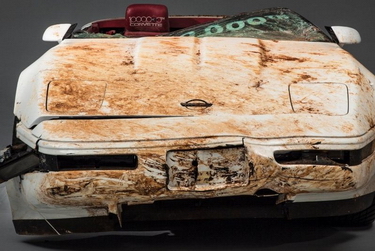Vette News - More Bad News - NCM Museum Sinkhole
1992 LT1 is running once again, but recently discovered signatures have complicated its restoration

General Motors has been working to restore the vintage Corvettes that were swallowed
by a sinkhole last year, but one model has proved particularly challenging, thanks to
some recent discoveries. As CNN reports, the white 1992 LT1 roadster - the millionth
Corvette ever produced - is now running, with its structural damage repaired, although
GM says only about 15 to 20 percent of the car has been restored.
The process has been complicated, in part, by the fact that many of the men and women
who assembled the car had signed their names all over its parts. Their signatures were
discovered in April, when the car was first taken apart, and they forced GM to rethink
its strategy in order to save all of the parts and preserve their names.
"Somebody took the time to write their name on the undercarriage," Dave Bolognino, GM's
director of design fabrications operations, tells CNN. "We need to take the time to make
sure that we straighten that piece of metal instead of replacing it."
The LT1 was one of eight cars that fell into a sinkhole under the National Corvette Museum
in Bowling Green, Kentucky, last year, and one of three that were deemed salvageable. GM
restored a 2009 ZR1 Blue Devil that fell into the sinkhole last year, while the museum plans
to restore a 1962 convertible on its own. The part of the museum where the sinkhole opened is
also nearly repaired, with its floor reinforced with micropiles and concrete beams. Underground
lights and cameras will be installed to allow visitors to see inside the sinkhole.
GM says it expects the LT1 to be restored by Labor Day weekend in early September, but there's
still a lot of work to be done. The car sustained significant damage to its paint and rear bumper,
which is tagged with several signatures. GM also has to decide whether or not to replace its hood,
which Bolognino describes as a question of "risk versus originality." "While we know we can repair
it, we don't want to see it degrade several years from now," he tells CNN. "So we're going to try
some things ... and then we'll make that decision."
Credit: NCM